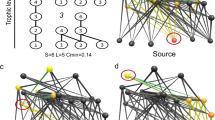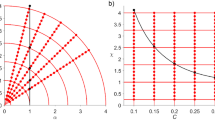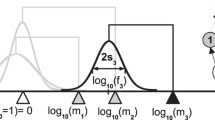Abstract
The effects of habitat connectivity on food webs have been studied both empirically and theoretically, yet the question of whether empirical results support theoretical predictions for any food web metric other than species richness has received little attention. Our synthesis brings together theory and empirical evidence for how habitat connectivity affects both food web stability and complexity. Food web stability is often predicted to be greatest at intermediate levels of connectivity, representing a compromise between the stabilizing effects of dispersal via rescue effects and prey switching, and the destabilizing effects of dispersal via regional synchronization of population dynamics. Empirical studies of food web stability generally support both this pattern and underlying mechanisms. Food chain length has been predicted to have both increasing and unimodal relationships with connectivity as a result of predators being constrained by the patch occupancy of their prey. Although both patterns have been documented empirically, the underlying mechanisms may differ from those predicted by models. In terms of other measures of food web complexity, habitat connectivity has been empirically found to generally increase link density but either reduce or have no effect on connectance, whereas a unimodal relationship is expected. In general, there is growing concordance between empirical patterns and theoretical predictions for some effects of habitat connectivity on food webs, but many predictions remain to be tested over a full connectivity gradient, and empirical metrics of complexity are rarely modeled. Closing these gaps will allow a deeper understanding of how natural and anthropogenic changes in connectivity can affect real food webs.

Similar content being viewed by others
References
Amarasekare P (2008) Spatial dynamics of foodwebs. Annu Rev Ecol Evol Syst 39:479–500
Bascompte J, Sole RV (1998) Effects of habitat destruction in a prey–predator metapopulation model. J Theor Biol 195:383–393
Basset A, Deangelis DL, Diffendorfer JE (1997) The effect of functional response on stability of a grazer population on a landscape. Ecol Model 101:153–162
Bonsall MB, French DR, Hassell MP (2002) Metapopulation structures affect persistence of predator–prey interactions. J Anim Ecol 71:1075–1084
Bonsall MB, Bull JC, Pickup NJ, Hassell MP (2005) Indirect effects and spatial scaling affect the persistence of multispecies metapopulations. Proc R Soc Biol Sci Ser B 272:1465–1471
Briggs CJ, Hoopes MF (2004) Stabilizing effects in spatial parasitoid–host and predator–prey models: a review. Theor Popul Biol 65:299–315
Cadenasso ML, Pickett STA (2001) Effect of edge structure on the flux of species into forest interiors. Conserv Biol 15:91–97
Cadotte MW (2006) Dispersal and species diversity: a meta-analysis. Am Nat 167:913–924
Cuddington K, Yodzis P (2000) Diffusion-limited predator–prey dynamics in euclidean environments: an allometric individual-based model. Theor Popul Biol 58:259–278
De Roos AM, McCauley E, Wilson WG (1991) Mobility versus density-limited predator–prey dynamics on different spatial scales. Proc R Soc Biol Sci Ser B 246:117–122
DeAngelis DL (1975) Stability and connectance in food web models. Ecology 56:238–243
Dunne JA, Williams RJ, Martinez ND (2002) Food-web structure and network theory: the role of connectance and size. Proc Natl Acad Sci USA 99:12917–12922
Elton C (1927) Animal ecology. Sidgwick and Jackson, London
Fahrig L (2003) Effects of habitat fragmentation on biodiversity. Annu Rev Ecol Evol Syst 34:487–515
Fenoglio MS, Srivastava D, Valladares G, Cagnolo L, Salvo A (2012) Forest fragmentation reduces parasitism via species loss at multiple trophic levels. Ecology 93:2407–2420
Gause GF (1934) The struggle for existence. Williams and Wilkins, Baltimore
Gilbert FS, Gonzalez A, Evans-Freke I (1998) Corridors maintain species richness in fragmented landscapes of a natural microecosystem. Proc R Soc Biol Sci Ser B 265:577–582
Gouhier TC, Guichard F, Gonzalez A (2010) Synchrony and stability of food webs in metacommunities. Am Nat 175:E16–E34
Gravel D, Canard E, Guichard F, Mouquet N (2011a) Persistence increases with diversity and connectance in trophic metacommunities. PLoS One 6:e19374
Gravel D, Massol F, Canard E, Mouillot D, Mouquet N (2011b) Trophic theory of island biogeography. Ecol Lett 14:1010–1016
Greig HS, Kratina P, Thompson PL, Palen WJ, Richardson JS, Shurin JB (2012) Warming, eutrophication, and predator loss amplify subsidies between aquatic and terrestrial ecosystems. Glob Change Biol 18:504–514
Hassell MP, Comins HN, May RM (1991) Spatial structure and chaos in insect population-dynamics. Nature 353:255–258
Holling CS (1959) The components of predation as revealed by a study of small-mammal predation of the european sawfly. Can Entomol 91:293–320
Holt RD (1993) Ecology at the mesoscale: the influence of regional processes on local communities. In: Ricklefs RE, Schluter D (eds) Species diversity in ecological communities. University of Chicago Press, Chicago, pp 77–88
Holt RD (1996) Food webs in space: An island biogeographical perspective. In: Polis GA, Winemiller KO (eds) Food webs: integration of patterns and dynamics. Chapman and Hall, New York, pp 313–323
Holt RD (1997) Community modules. In: Gange AC, Brown VK (eds) Multitrophic interactions in terrestrial systems: the 36th Symp British Ecological Society. Blackwell Science, John Wiley & Sons, Hoboken, pp 333–350
Holt RD (2009) Toward a trophic island biogeography. In: Losos JB, Ricklefs RE (eds) The theory of island biogeography revisited. Princeton University Press, Princeton, pp 143–185
Holt RD, Hoopes MF (2005) Food web dynamics in a metacommunity context. In: Holyoak M, Leibold MA, Holt RD (eds) Metacommunities spatial dynamics and ecological communities. The University of Chicago Press, Chicago, pp 68–93
Holt RD, Lawton JH (1994) The ecological consequences of shared natural enemies. Annu Rev Ecol Syst 25:495–520
Holt RD, Lawton JH, Polis GA, Martinez ND (1999) Trophic rank and the species-area relationship. Ecology 80:1495–1504
Holyoak M (2000a) Habitat patch arrangement and metapopulation persistence of predators and prey. Am Nat 156:378–389
Holyoak M (2000b) Habitat subdivision causes changes in food web structure. Ecol Lett 3:509–515
Howeth JG, Leibold MA (2010) Species dispersal rates alter diversity and ecosystem stability in pond metacommunities. Ecology 91:2727–2741
Hoyle M, Gilbert F (2004) Species richness of moss landscapes unaffected by short-term fragmentation. Oikos 105:359–367
Huffaker CB (1958) Experimental studies on predation: dispersion factors and predator-prey oscillations. Hilgardia 27:795–835
Ives AR, Carpenter SR (2007) Stability and diversity of ecosystems. Science 317:58–62
Jansen VAA (1995) Regulation of predator-prey systems through spatial interactions: a possible solution to the paradox of enrichment. Oikos 74:384–390
Kaartinen R, Roslin T (2011) Shrinking by numbers: landscape context affects the species composition but not the quantitative structure of local food webs. J Anim Ecol 80:622–631
Komonen A, Penttila R, Lindgren M, Hanski I (2000) Forest fragmentation truncates a food chain based on an old-growth forest bracket fungus. Oikos 90:119–126
Layman CA, Quattrochi JP, Peyer CM, Allgeier JE (2007) Niche width collapse in a resilient top predator following ecosystem fragmentation. Ecol Lett 10:937–944
Leibold MA, Holyoak M, Mouquet N, Amarasekare P, Chase JM, Hoopes MF, Holt RD, Shurin JB, Law R, Tilman D, Loreau M, Gonzalez A (2004) The metacommunity concept: a framework for multi-scale community ecology. Ecol Lett 7:601–613
Levins R (1969) Some demographic and genetic consequences of environmental heterogeneity for biological control. Bull Entomol Soc Am 15:237–240
Liebhold A, Koenig WD, Bjornstad ON (2004) Spatial synchrony in population dynamics. Annu Rev Ecol Evol Syst 35:467–490
Lin WT, Hsieh CH, Miki T (2013) Difference inadaptive dispersal ability can promote species coexistence in fluctuating environments. PLoS One 8:e55218
Lookingbill TR, Gardner RH, Ferrari JR, Keller CE (2010) Combining a dispersal model with network theory to assess habitat connectivity. Ecol Appl 20:427–441
Loreau M, Mouquet N, Gonzalez A (2003) Biodiversity as spatial insurance in heterogeneous landscapes. Proc Natl Acad Sci USA 100:12765–12770
MacArthur RH, Wilson EO (1967) The theory of island biogeography. Princeton Universtiy Press, Princeton
Martinez ND (1992) Constant connectance in community food webs. Am Nat 139:1208–1218
Matter SF, Ezzeddine M, Duermit E, Mashburn J, Hamilton R, Lucas T, Roland J (2009) Interactions between habitat quality and connectivity affect immigration but not abundance or population growth of the butterfly, Parnassius smintheus. Oikos 118:1461–1470
May RM (1973) Stability and complexity in model ecosystems. Princeton University Press, Princeton
May RM (1994) The effects of spatial scale on ecological questions and answers. In: Edwards PJ, May RM, Webb NR (eds) Large scale ecology and conservation biology. Blackwell Scientific Publications, Oxford, pp 1–17
McCann KS (2000) The diversity–stability debate. Nature 405:228–233
McCann KS, Rasmussen JB, Umbanhowar J (2005) The dynamics of spatially coupled food webs. Ecol Lett 8:513–523
McCauley E, Wilson WG, de Roos AM (1993) Dynamics of age-structured and spatially structured predator–prey interactions: individual-based models and population-level formulations. Am Nat 142:412–442
McKinney ML, Lockwood JL (1999) Biotic homogenization: a few winners replacing many losers in the next mass extinction. Trends Ecol Evol 14:450–453
Moilanen A, Nieminen M (2002) Simple connectivity measures in spatial ecology. Ecology 83:1131–1145
Murakami M, Hirao T, Kasei A (2008) Effects of habitat configuration on host–parasitoid food web structure. Ecol Res 23:1039–1049
Murdoch WW (1977) Stabilizing effects of spatial heterogeneity in predator–prey systems. Theor Popul Biol 11:252–273
Murdoch WW, Avery S, Smyth MEB (1975) Switching in predatory fish. Ecology 56:1094–1105
Myers JH (1976) Distribution and dispersal in populations capable of resource depletion: a simulation model. Oecologia 23:255–269
Opermanis O, MacSharry B, Aunins A, Sipkova Z (2012) Connectedness and connectivity of the Natura 2000 network of protected areas across country borders in the European Union. Biol Conserv 153:227–238
Paillex A, Castella E, Carron G (2007) Aquatic macroinvertebrate response along a gradient of lateral connectivity in river floodplain channels. J North Am Benthol Soc 26:779–796
Piechnik DA, Lawler SP, Martinez ND (2008) Food-web assembly during a classic biogeographic study: species’ “Trophic breadth” corresponds to colonization order. Oikos 117:665–674
Pillai P, Loreau M, Gonzalez A (2010) A patch-dynamic framework for food web metacommunities. Theor Ecol 3:223–237
Pillai P, Gonzalez A, Loreau M (2011) Metacommunity theory explains the emergence of food web complexity. Proc Natl Acad Sci USA 108:19293–19298
Pimm SL (1982) Food webs. Chapman and Hall, London
Pimm SL, Lawton JH (1978) Feeding on more than one trophic level. Nature 275:542–544
Pimm SL, Lawton JH, Cohen JE (1991) Food web patterns and their consequences. Nature 350:669–674
Polis GA, Hurd SD (1995) Extraordinarily high spider densities on islands—flow of energy from the marine to terrestrial food webs and the absence of predation. Proc Natl Acad Sci USA 92:4382–4386
Post DM (2002) The long and short of food-chain length. Trends Ecol Evol 17:269–277
Prevedello JA, Vieira MV (2010) Does the type of matrix matter? A quantitative review of the evidence. Biodivers Conserv 19:1205–1223
Prugh LR, Hodges KE, Sinclair ARE, Brashares JS (2008) Effect of habitat area and isolation on fragmented animal populations. Proc Natl Acad Sci USA 105:20770–20775
Roach KA, Thorp JH, Delong MD (2009) Influence of lateral gradients of hydrologic connectivity on trophic positions of fishes in the upper Mississippi river. Freshw Biol 54:607–620
Rooney N, McCann KS, Moore JC (2008) A landscape theory for food web architecture. Ecol Lett 11:867–881
Rose MD, Polis GA (1998) The distribution and abundance of coyotes: the effects of allochthonous food subsidies from the sea. Ecology 79:998–1007
Scheid BE, Thies C, Tscharntke T (2011) Enhancing rape pollen beetle parasitism within sown flower fields along a landscape complexity gradient. Agric Entomol 13:173–179
Schneider K, Scheu S, Maraun M (2007) Microarthropod density and diversity respond little to spatial isolation. Basic Appl Ecol 8:26–35
Shackell NL, Fisher JAD, Frank KT, Lawton P (2012) Spatial scale of similarity as an indicator of metacommunity stability in exploited marine systems. Ecol Appl 22:336–348
Shulman RS, Chase JM (2007) Increasing isolation reduces predator: prey species richness ratios in aquatic food webs. Oikos 116:1581–1587
Simberloff DS, Wilson EO (1969) Experimental zoogeography of islands—coloniation of empty islands. Ecology 50:278
Simberloff DS, Wilson EO (1970) Experimental zoogeography of island—a 2-year record of colonization. Ecology 51:934
Spencer M (1997) The effects of habitat size and energy on food web structure: an individual-based cellular automata model. Ecol Model 94:299–316
Staddon P, Lindo Z, Crittenden PD, Gilbert F, Gonzalez A (2010) Connectivity, non-random extinction and ecosystem function in experimental metacommunities. Ecol Lett 13:543–552
Starzomski BM, Srivastava DS (2007) Landscape geometry determines community response to disturbance. Oikos 116:690–699
Terborgh J, Lopez L, Nunez P, Rao M, Shahabuddin G, Orihuela G, Riveros M, Ascanio R, Adler GH, Lambert TD, Balbas L (2001) Ecological meltdown in predator-free forest fragments. Science 294:1923–1926
Tischendorf L, Fahrig L (2000) How should we measure landscape connectivity? Landsc Ecol 15:633–641
Valladares G, Cagnolo L, Salvo A (2012) Forest fragmentation leads to food web contraction. Oikos 121:299–305
Vandermeer J (1973) Regional stabilization of locally unstable predator–prey relationships. J Theor Biol 41:161–170
Vannote RL, Minshall GW, Cummins KW, Sedell JR, Cushing CE (1980) River continnum concept. Can J Fish Aquat Sci 37:130–137
Vasseur DA, Fox JW (2009) Phase-locking and environmental fluctuations generate synchrony in a predator-–rey community. Nature 460:1007–1007
Vogwill T, Fenton A, Brockhurst MA (2009) Dispersal and natural enemies interact to drive spatial synchrony and decrease stability in patchy populations. Ecol Lett 12:1194–1200
Warren PH (1994) Making connections in food webs. Trends Ecol Evol 9:136–141
Watling JI, Donnelly MA (2006) Fragments as islands: a synthesis of faunal responses to habitat patchiness. Conserv Biol 20:1016–1025
Willson MF, Gende SM, Bisson PA (2004) Anadromous fishes as ecological links beween ocean, fresh water, and land. In: Polis GA, Power ME, Huxel GR (eds) Food webs at the landscape level. The University of Chicago Press, Chicago, pp 284–300
Wilson HB, Hassell MP, Holt RD (1998) Persistence and area effects in a stochastic tritrophic model. Am Nat 151:587–595
Acknowledgments
This work was funded with the assistance of the Government of Canada/avec l’appui du Gouvernement du Canada, by doctoral, postdoctoral and Discovery grants from the Natural Sciences and Engineering Research Council of Canada to RML, PK and DS, respectively. We also thank Jana Petermann, Andrew MacDonald, Nathan Kraft, Hamish Greig, and Ross Thompson for valuable comments that improved this paper.
Author information
Authors and Affiliations
Corresponding author
Additional information
Communicated by Raphael Didham.
Electronic supplementary material
Below is the link to the electronic supplementary material.
Rights and permissions
About this article
Cite this article
LeCraw, R.M., Kratina, P. & Srivastava, D.S. Food web complexity and stability across habitat connectivity gradients. Oecologia 176, 903–915 (2014). https://doi.org/10.1007/s00442-014-3083-7
Received:
Accepted:
Published:
Issue Date:
DOI: https://doi.org/10.1007/s00442-014-3083-7




